Have you ever wondered how personalized response prompt strategies in Applied Behavior Analysis (ABA) can truly make a difference for children with autism? 🌟 This article dives into just that! It highlights how tailored approaches—like verbal, visual, and physical prompts—are not just helpful but essential for boosting communication, social skills, and independence.
Imagine a child who thrives when their learning is customized just for them. Studies show that when interventions are individualized to fit each child's unique needs, the educational benefits can be significant. This isn’t just theory; it’s backed by real evidence!
As parents, you face challenges in finding the right strategies that resonate with your child. It can be overwhelming, but remember, you’re not alone in this journey. Let’s explore this together! By understanding the power of personalized approaches, you can take steps toward enhancing your child’s learning experience. We’re here to help you every step of the way!
The journey of learning for children with autism can be filled with unique challenges and wonderful opportunities. It’s important to recognize that tailored approaches can make a significant difference. Personalized response prompt strategies in Applied Behavior Analysis (ABA) shine as a beacon of hope, offering effective methods to enhance communication, social skills, and independence. But how can caregivers and educators effectively implement these strategies to ensure that each child not only learns but truly thrives?
Let’s explore this together! In this article, we’ll delve into ten practical response prompt examples that can transform the learning experience. We’ll provide insights into the methods that really make a difference, helping you feel empowered and supported every step of the way.
Rori Care - ABA Therapy emphasizes the significance of personalized response prompt ABA example strategies in ABA therapy. These tailored approaches are thoughtfully crafted to meet the unique educational needs of each individual, making sure that interventions are not only effective but also engaging. By leveraging data-driven techniques and advanced AI, clinicians can track progress and even pre-create reports, giving them 50% more time for direct treatment. This personalized approach helps improve communication and social skills while fostering greater independence in young people with autism, leading to better educational outcomes.
Research shows that peer tutoring can significantly impact both academic and social-behavior outcomes, reinforcing the effectiveness of personalized strategies in enhancing learning. The expertise of qualified behavior analysts is vital as they design individualized plans with measurable goals and evidence-based strategies, paving the way for positive behavior changes. Case studies reveal that personalized methods, such as electronic daily behavior report cards (eDBRCs), act as a response prompt ABA example by effectively reducing non-compliant and disruptive behaviors, showcasing the practical application of data-driven strategies in autism care.
Let’s explore this together! We’re here to help you every step of the way!
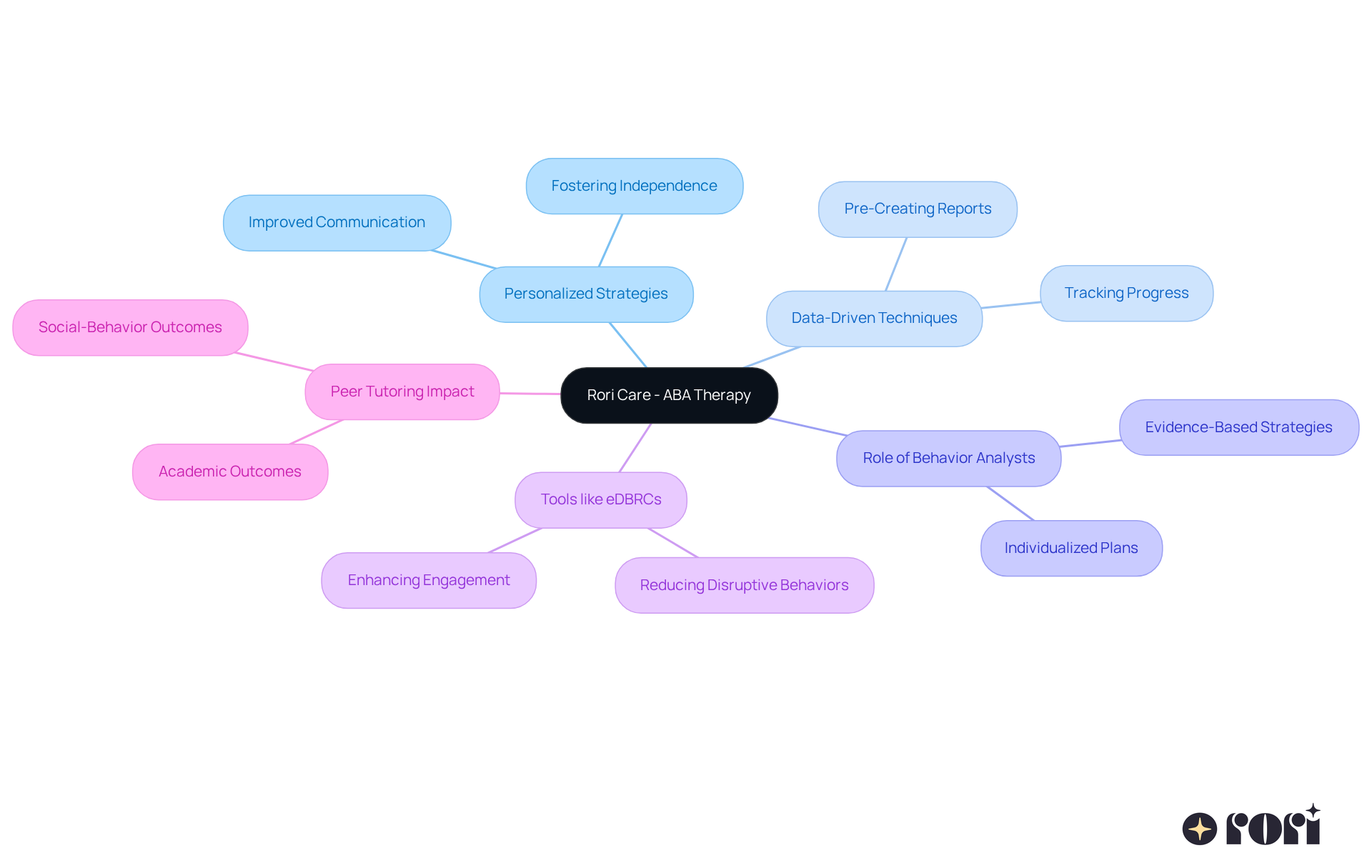
Verbal cues are like little spoken signals that encourage our young ones to join in and share their thoughts. For example, when you ask a child, 'What do you want to play with?' it’s a direct nudge for them to express their wishes. This not only helps them build their communication skills but also boosts their confidence in social situations.
Did you know that using verbal cues regularly can really enhance expressive language skills? It allows kids to convey their needs and emotions more effectively. By weaving these cues into everyday conversations, caregivers can create an environment that promotes language growth and inspires kids to engage more actively in discussions. Let’s explore this together!
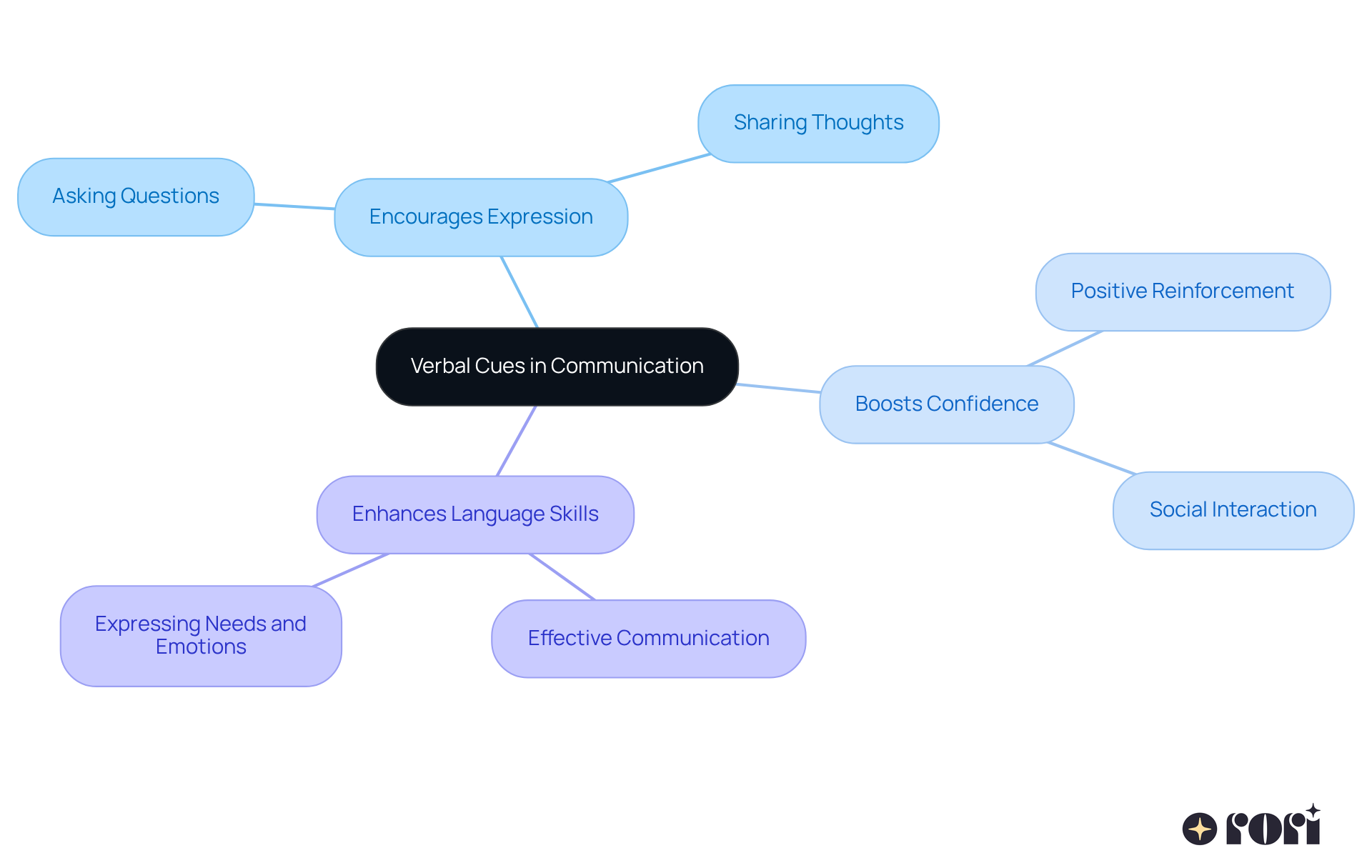
Visual cues are such a fantastic way to enhance learning experiences for individuals with autism! 🌟 For instance, a visual timetable can beautifully illustrate the order of daily tasks, helping kids understand what to expect throughout their day. Did you know that most autistic students are visual learners? This means they often grasp information better through visual means rather than just listening to instructions. By offering clear visual representations, we not only help with understanding but also encourage engagement and ease anxiety.
In fact, the effective use of visual aids in ABA therapy, such as the response prompt aba example, has shown to improve academic-related on-task behaviors. This makes them an essential resource in supporting our youth's growth and development. As one expert pointed out, visual supports are crucial in helping individuals with autism communicate and connect with their environment.
Overall, using visual aids in educational settings can lead to fantastic learning outcomes, allowing students to thrive both academically and socially. Let’s explore this together and see how we can make a positive impact!
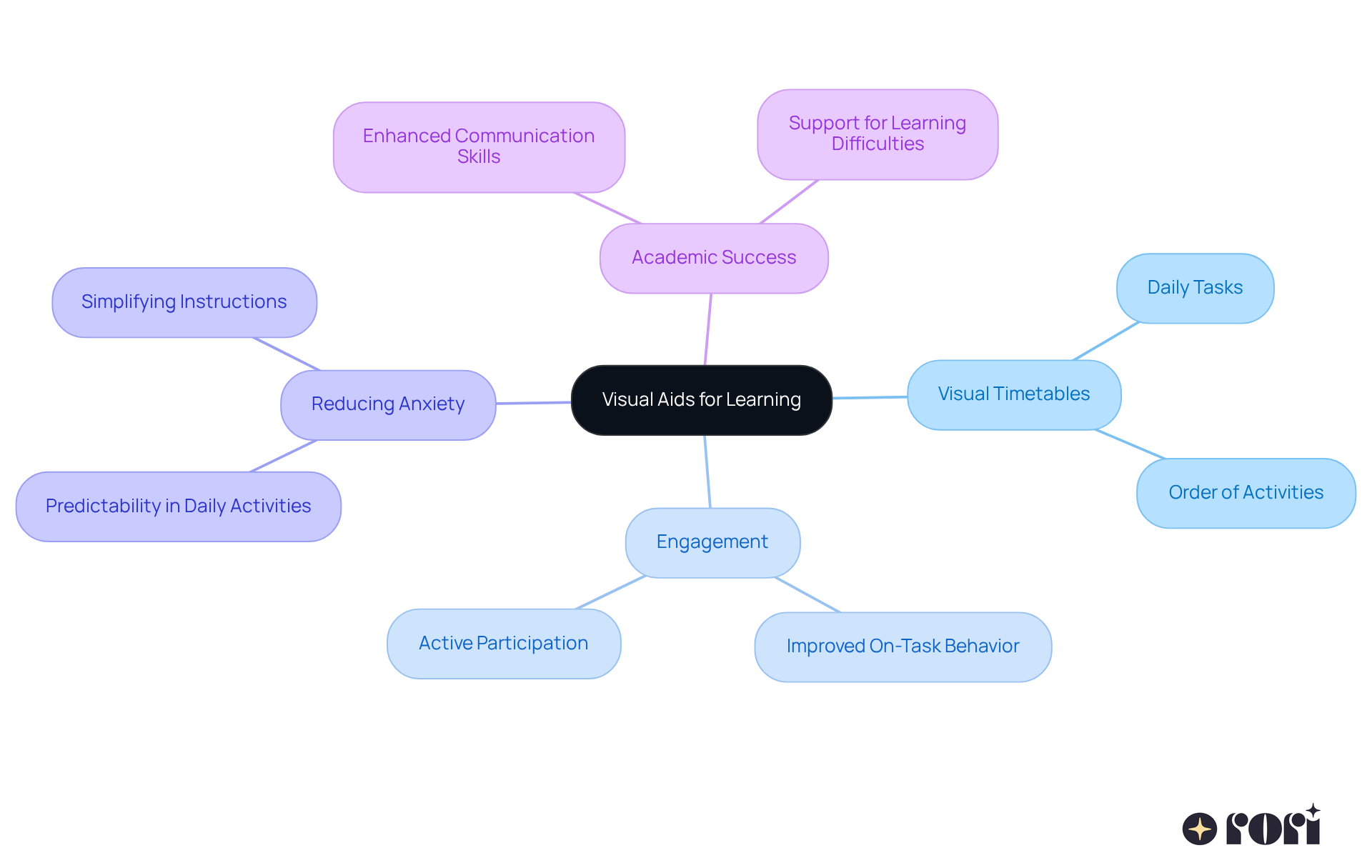
Physical prompts play a vital role in ABA therapy, providing direct assistance to guide a young person's actions. For example, a response prompt aba example can involve a caregiver gently guiding a child's hands through the motions when teaching them to tie their shoes. This hands-on help not only clarifies how to do the task but also builds confidence, encouraging the child to give it a try on their own.
Research shows that this kind of physical support really boosts skill acquisition, allowing kids to learn through active participation. As they become more skilled, the level of physical assistance can be gradually reduced, fostering greater independence. This gradual fading of help is crucial; it empowers children to master tasks on their own, nurturing their self-efficacy and confidence.
When caregivers effectively use physical cues and keep track of progress, it ensures that children can move from relying on assistance to completing tasks independently. This lays the groundwork for success in various life skills. Plus, as caregivers deepen their understanding of ABA principles through education, they become better equipped to provide the right support at home. This not only complements professional interventions but also promotes consistency.
Did you know that significant progress is noted in 90% of youngsters when suggested hours are fully executed with adult involvement? By enhancing their knowledge and skills, caregivers not only reduce stress but also improve family dynamics, leading to better behavioral outcomes for their children. Let’s explore this together!
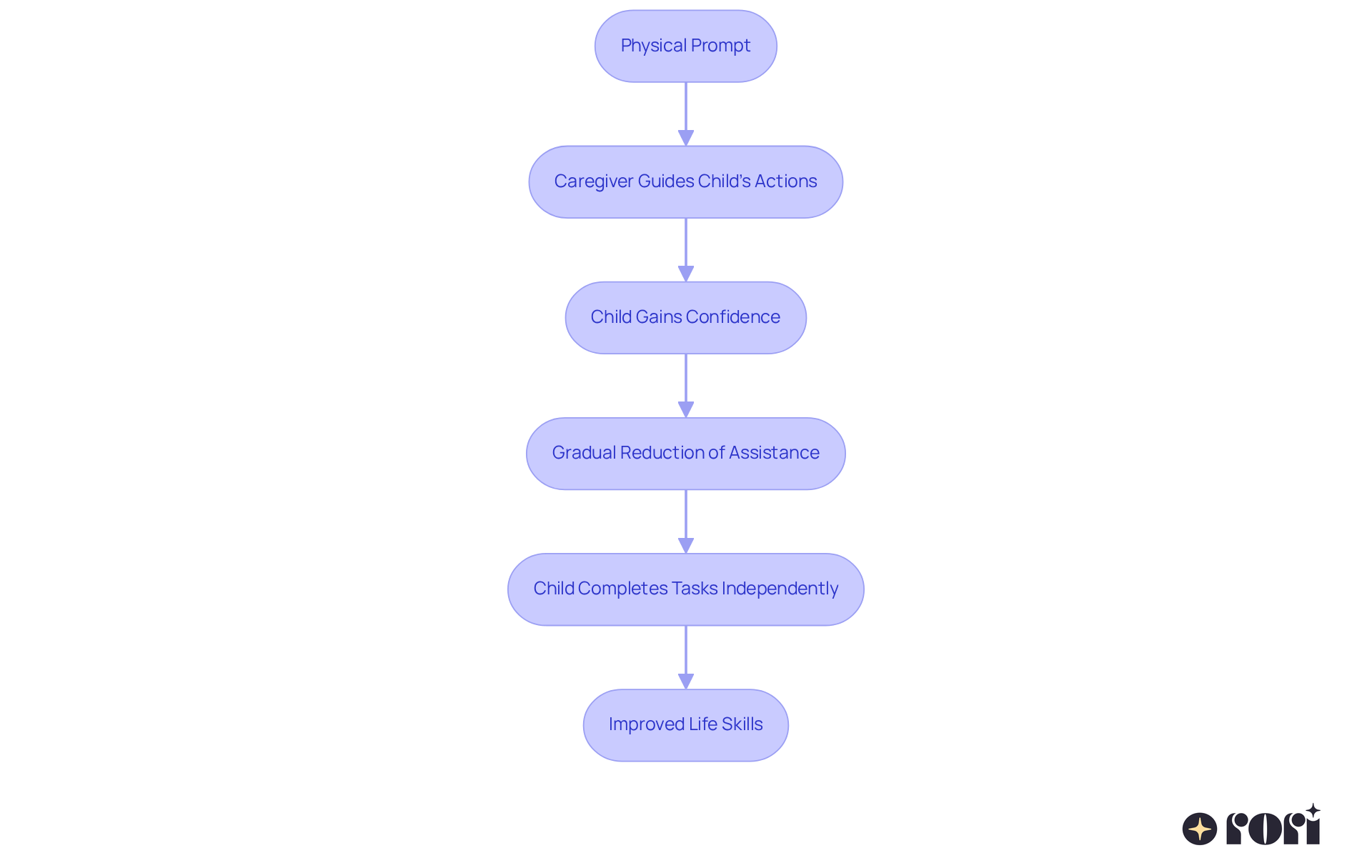
Model prompts serve as a response prompt aba example in ABA therapy, helping kids learn by observing and replicating desired behaviors. For example, a therapist might use a response prompt aba example by demonstrating how to greet a peer with, 'Hi, my name is...' This not only teaches the specific behavior but also serves as a clear example of social interaction.
Studies reveal that children with autism benefit immensely from observational experiences. They often thrive when they can see behaviors demonstrated in real-time. By watching and imitating these modeled behaviors, young individuals can naturally and engagingly acquire new skills, ultimately boosting their social competence.
Experts emphasize that using a response prompt aba example for effective modeling can lead to improved communication and interaction skills. It reinforces the idea that children learn best when they are actively involved in the learning process. Support provider education is crucial here, equipping caregivers with the knowledge and skills needed to effectively assist in their children's development.
For instance, caregivers who grasp ABA principles can implement strategies at home that reinforce skills learned in therapy, paving the way for better behavioral outcomes. Plus, social skills group therapy, led by qualified therapists, can further enhance communication and relationships, providing a supportive space for kids to practice these abilities alongside their peers.
Let’s explore this together! We’re here to help you every step of the way!
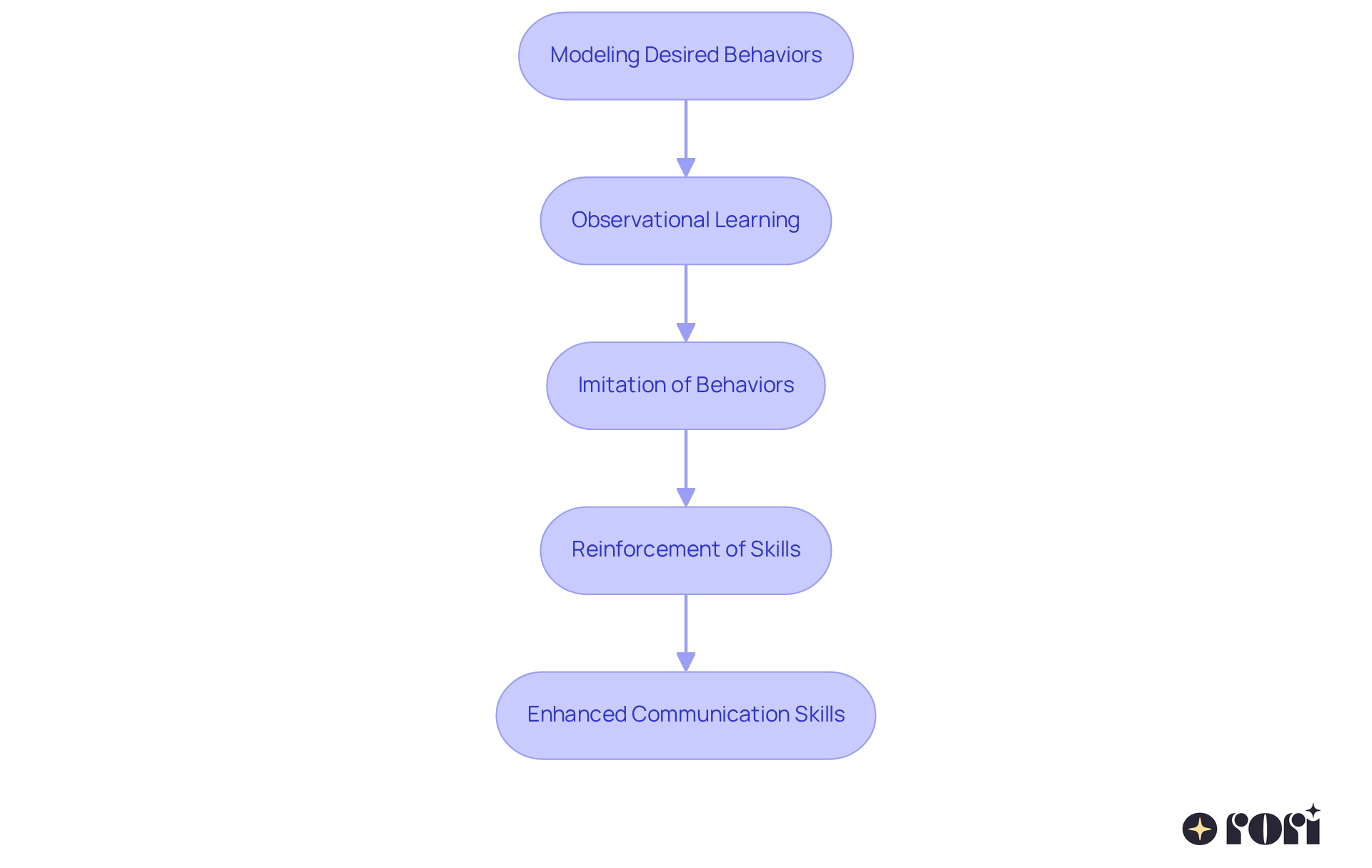
Gestural prompts are a wonderful way to use hand signals and body language to convey messages or instructions effectively. For example, when you point to an object, it can inspire a young person to recognize or engage with it. This non-verbal strategy is especially helpful for kids who might struggle with verbal communication, offering them an alternative way to understand and respond.
Did you know that about 25-30% of children diagnosed with autism spectrum disorder remain minimally verbal or nonverbal into adulthood? This highlights the importance of effective communication strategies. By incorporating gestures into daily interactions, caregivers can significantly boost communication and comprehension, creating a more inclusive environment for learning.
Recent studies show that using non-verbal cues not only helps with immediate understanding but also supports long-term communication development. This makes it a vital part of the response prompt ABA example! Caregivers can implement gestural prompts by using consistent hand signals for common requests—like a wave for 'hello' or a thumbs-up for 'good job.'
As Ido Kedar emphasizes, presuming competence in nonverbal individuals is key. It allows for a more respectful and effective approach to communication. Plus, education for providers is crucial in helping parents feel confident applying these strategies, leading to better behavioral outcomes for their kids.
Techniques like the Picture Exchange Communication System (PECS) illustrate how non-verbal signals can serve as a response prompt ABA example in ABA therapy. This not only aids in communication growth for young individuals but also empowers caregivers to make informed choices and provide steady support. Let’s explore this together!
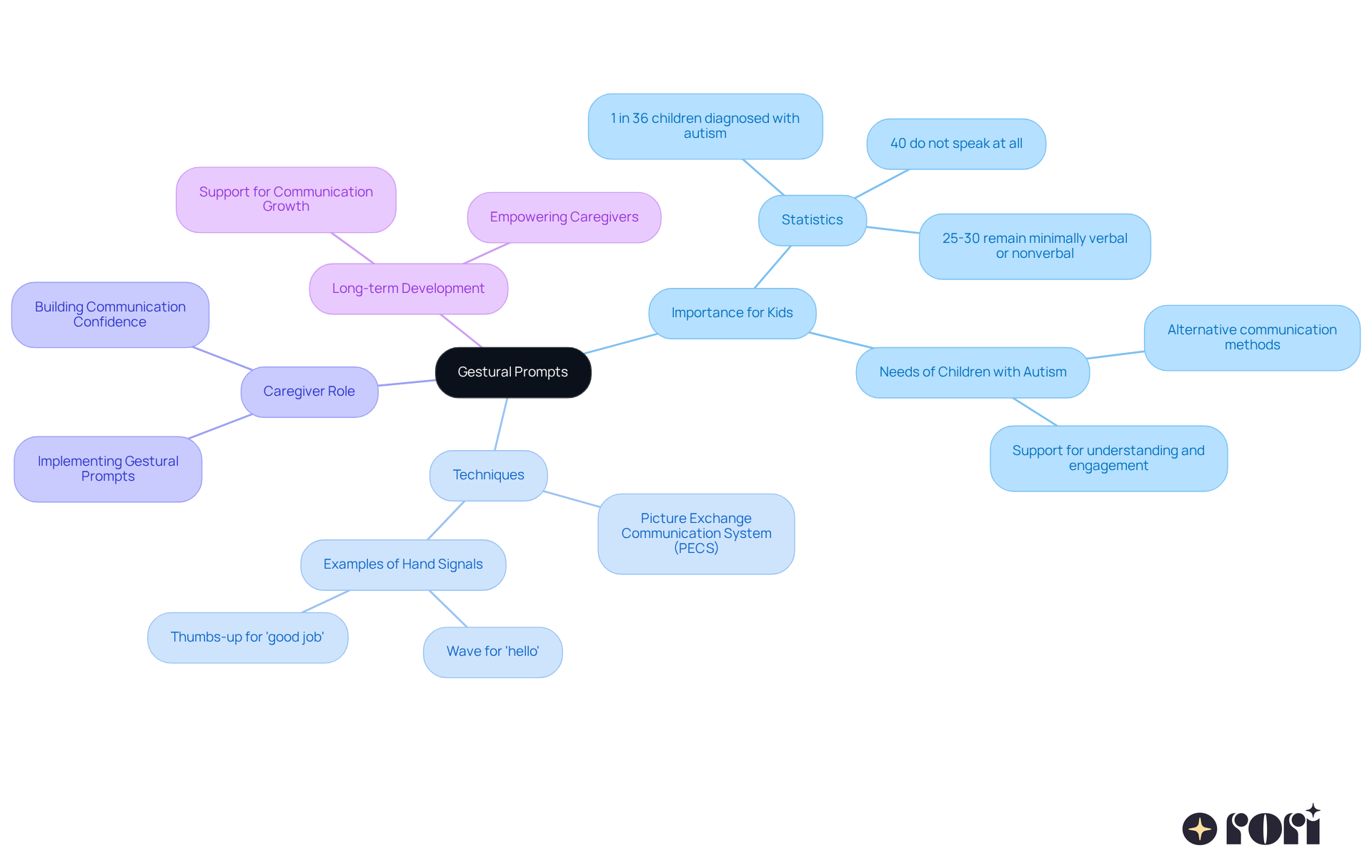
Positional prompts are such a handy tool in Applied Behavior Analysis (ABA)! They involve placing objects or materials in a way that really captures a young person's attention and helps them engage. For instance, when teaching colors, if you put colorful blocks right in front of a child, it can significantly boost their interest in the activity. This method not only creates a space that's perfect for exploration but also helps kids focus on the materials that matter, making their learning experience even richer.
Qualified behavior analysts are key in crafting and putting these strategies into action, making sure they fit the unique needs of each child. By creating a warm and welcoming environment, instructors and supporters can effectively meet the developmental needs of young ones and encourage them to dive into their educational journey. Plus, with clear progress tracking, parents can easily see how involved their child is and how well they understand, which allows for necessary adjustments.
The ongoing assessment process ensures these interventions stay effective and flexible, adapting to each child's evolving needs. This not only fosters lasting positive change but also empowers both the child and their caregivers throughout the educational journey. Let’s explore this together and see how we can make learning fun and engaging!
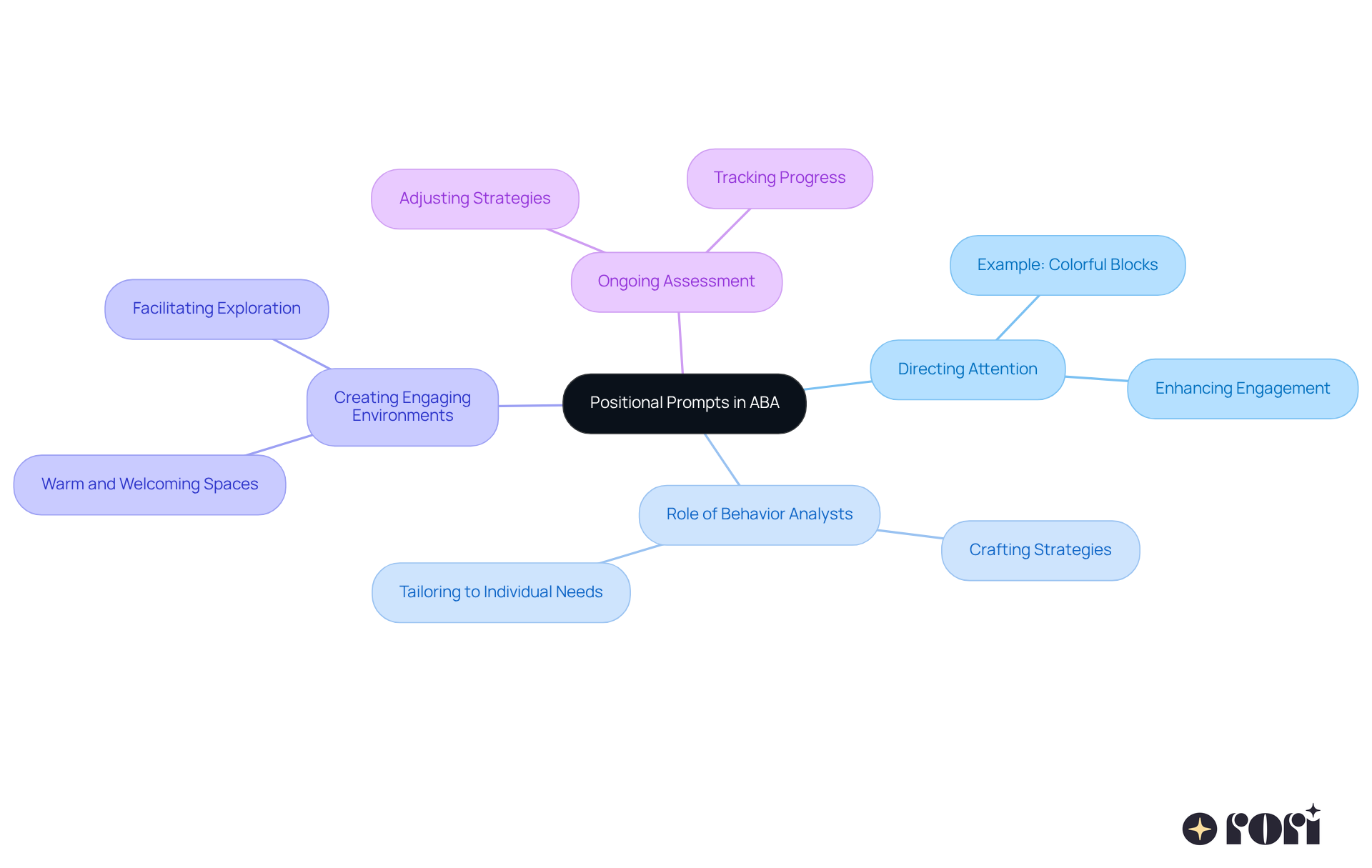
Environmental cues play a vital role in creating a nurturing environment for individuals with autism. By making simple adjustments like reducing noise levels, organizing materials, and setting up designated study areas, we can really make a difference. For example, imagine a tranquil space adorned with soothing images—this can significantly boost a young person’s ability to focus during educational tasks.
When we tailor the surroundings to meet each individual's unique needs, we help enhance their involvement and minimize distractions. This, in turn, leads to better educational outcomes. Research shows that organized settings not only reduce anxiety but also improve concentration, allowing children to navigate their educational experiences more effectively.
The impact of these changes is profound! They create a more supportive environment for skill acquisition and behavioral growth, particularly through a response prompt ABA example. Rori Care is here to empower caregivers with the knowledge and skills to implement these strategies effectively. We emphasize the importance of data collection to track progress and adjust interventions as needed.
Moreover, the principles of Natural Environment Teaching (NET) remind us how crucial it is to teach in natural and meaningful contexts. This approach can enhance the effectiveness of our environmental modifications. Did you know that studies show 60% of participants in ABA therapy experience gains in intellectual functioning? This highlights just how beneficial structured environments can be for learning outcomes.
Caregiver participation is key! It strengthens the skills acquired in therapy and supports the young one's growth in daily environments. So, let’s explore this together! We’re here to help you every step of the way!
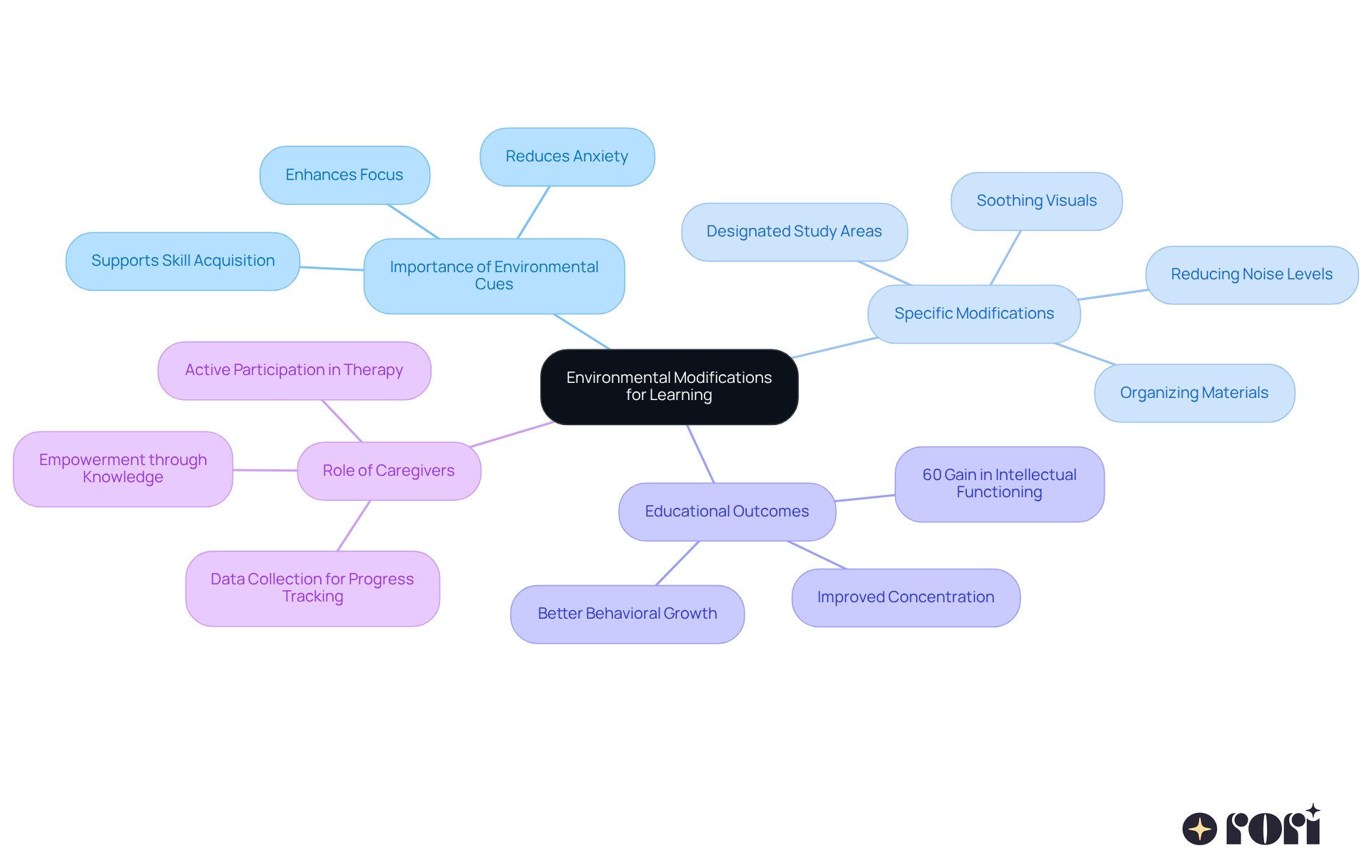
Fading prompts are all about helping our little ones become more independent by gradually stepping back as they learn. Imagine teaching a child to brush their teeth—at first, you might be right there, providing full support. But as they gain confidence and skill, you can slowly reduce your involvement. This approach not only boosts their independence but also builds their self-efficacy, allowing them to take charge of their learning and daily routines.
Recent studies show that children with autism can really benefit from this gradual assistance method. Research indicates a daily increase of 0.251 in independent joint attention skills as cues are minimized. Plus, in ABA therapy, we've seen that as physical cues decrease, kids often show more autonomy in their behaviors. This reinforces the idea that nurturing self-reliance is key to their growth.
Experts emphasize the importance of continuously evaluating and adjusting the level of support we provide. It’s essential to meet each child’s evolving needs, ensuring they’re both challenged and supported. Education for caregivers plays a vital role here, equipping you with the knowledge to effectively implement fading cues.
To start using fading cues in your daily life, consider beginning with full support for a specific task. Then, as your child becomes more skilled, gradually decrease your involvement while celebrating their progress along the way. This method not only enhances behavioral outcomes but also empowers you as a caregiver, enabling you to make informed choices that positively impact your child's development. Let’s explore this together!
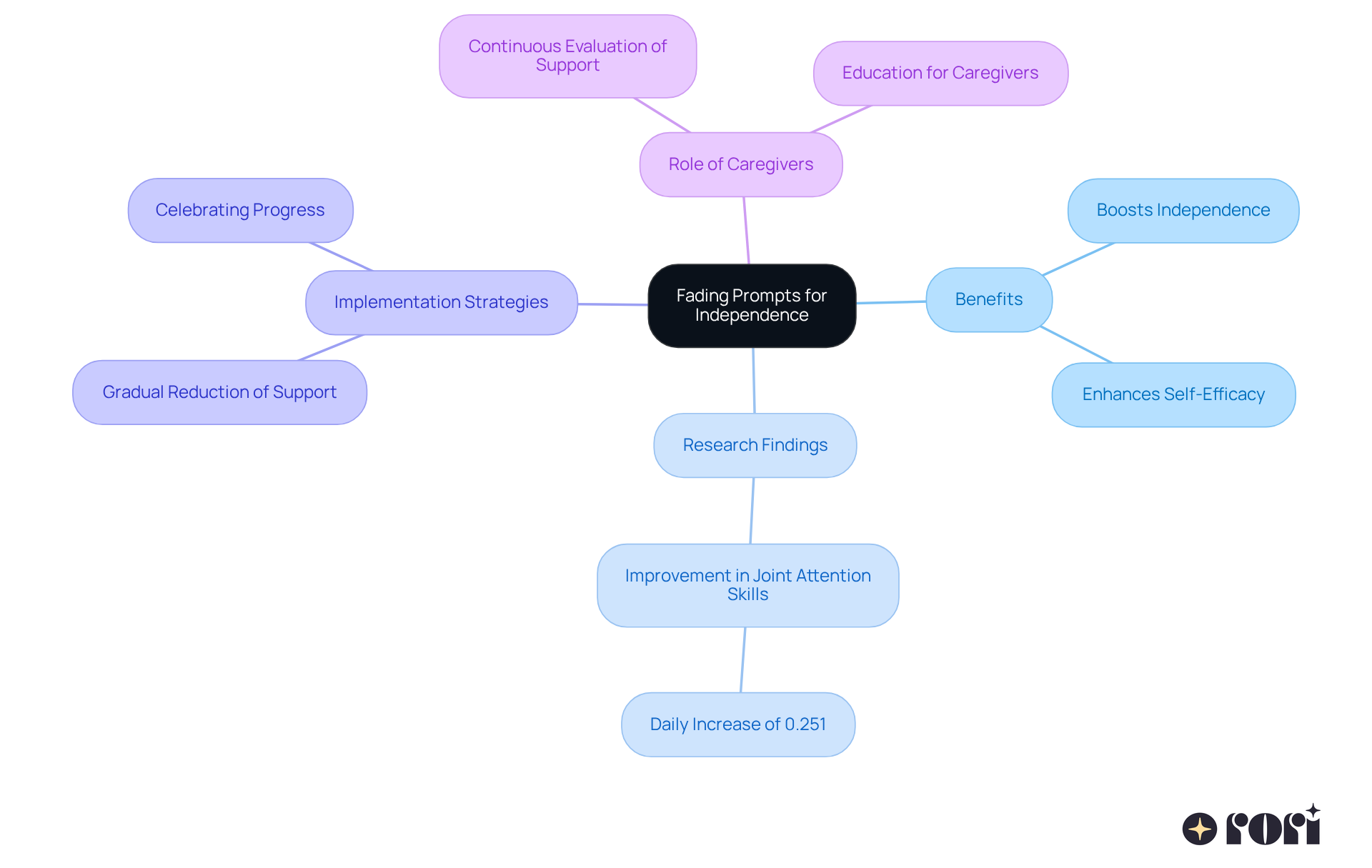
The effectiveness of the response prompt ABA example is fundamentally connected to their individualization. Every individual with autism has unique strengths, challenges, and styles of acquiring knowledge. That’s why it’s so important to apply customized approaches that fit their particular needs. At Rori Care, our qualified behavior analysts focus on individualized planning, ensuring that each behavioral plan is tailor-made to fit the unique needs, strengths, challenges, and goals of the client.
By carefully evaluating each youngster's skills and interests, caregivers can choose the most impactful response prompt ABA example. This greatly improves participation and educational results! Studies show that the use of a response prompt ABA example not only enhances the educational experience but also empowers young individuals to thrive in their academic journeys. For instance, research indicates that personalized educational methods can lead to significant improvements in student success, helping young learners benefit from techniques that address their distinct cognitive profiles.
This customized approach acts as a response prompt ABA example, encouraging autonomy and enabling youngsters to acquire new abilities more efficiently while minimizing frustration throughout the learning experience. Additionally, our evidence-based strategies, including the time delay method and least-to-most prompting, act as a response prompt ABA example that further enhances the effectiveness of individualized approaches. By setting clear, measurable goals and continuously evaluating progress, Rori Care empowers caregivers to support their children's behavioral goals through active involvement and data collection.
Let’s explore this together! We’re here to help you every step of the way!
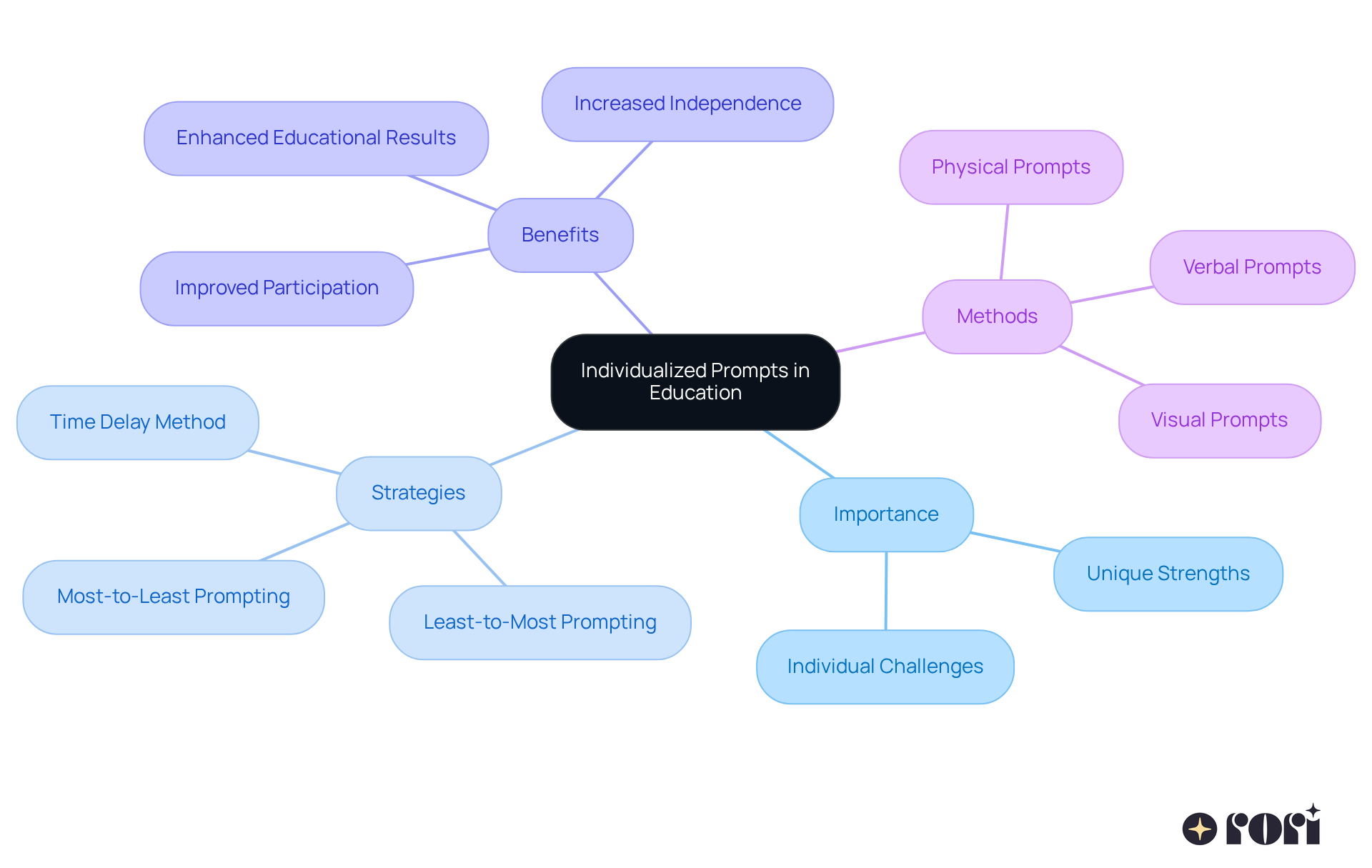
As we wrap up, it’s clear that personalized response prompt strategies play a pivotal role in enhancing the learning journey for children with autism. By tailoring our approaches to meet each child's unique needs, we can help facilitate effective communication, improve social skills, and foster independence in our young learners. This article has showcased various response prompt examples, illustrating how these strategies can create a more engaging and supportive educational experience.
Some key insights include the significance of:
Each type serves its own purpose, guiding children through their learning processes—whether it’s encouraging communication, providing hands-on support, or modifying the learning environment. It’s all about customizing the learning experience to align with each child’s strengths and challenges.
Ultimately, we cannot underestimate the importance of implementing personalized response prompts. By embracing these strategies, we empower children with autism to thrive both academically and socially. The journey toward effective learning is a collaborative one, and with the right tools and support, every child can reach their full potential. Let’s explore this together! We’re here to help you every step of the way!
What is the main focus of Rori Care - ABA Therapy?
Rori Care - ABA Therapy emphasizes personalized response prompt strategies in ABA therapy, tailored to meet the unique educational needs of individuals, particularly those with autism.
How does personalized ABA therapy benefit individuals with autism?
Personalized ABA therapy helps improve communication and social skills while fostering greater independence, leading to better educational outcomes for young people with autism.
What role do qualified behavior analysts play in ABA therapy?
Qualified behavior analysts design individualized plans with measurable goals and evidence-based strategies, which are essential for achieving positive behavior changes.
How does peer tutoring relate to ABA therapy?
Research shows that peer tutoring can significantly enhance both academic and social-behavior outcomes, reinforcing the effectiveness of personalized strategies in learning.
What are electronic daily behavior report cards (eDBRCs)?
eDBRCs are personalized methods used in ABA therapy to act as response prompts, effectively reducing non-compliant and disruptive behaviors.
What are verbal prompts, and how do they aid communication?
Verbal prompts are spoken cues that encourage children to express their thoughts and needs, helping to build their communication skills and confidence in social situations.
How can caregivers enhance expressive language skills in children?
By regularly using verbal cues in everyday conversations, caregivers can create an environment that promotes language growth and encourages active engagement in discussions.
What is the significance of visual prompts in ABA therapy?
Visual prompts, such as visual timetables, enhance learning experiences by providing clear representations that help individuals with autism understand tasks and reduce anxiety.
Why are visual aids particularly effective for autistic students?
Most autistic students are visual learners, meaning they often grasp information better through visual means rather than just listening, leading to improved academic-related on-task behaviors.
What overall impact do visual aids have in educational settings for individuals with autism?
The effective use of visual aids in educational settings can lead to fantastic learning outcomes, allowing students to thrive both academically and socially.